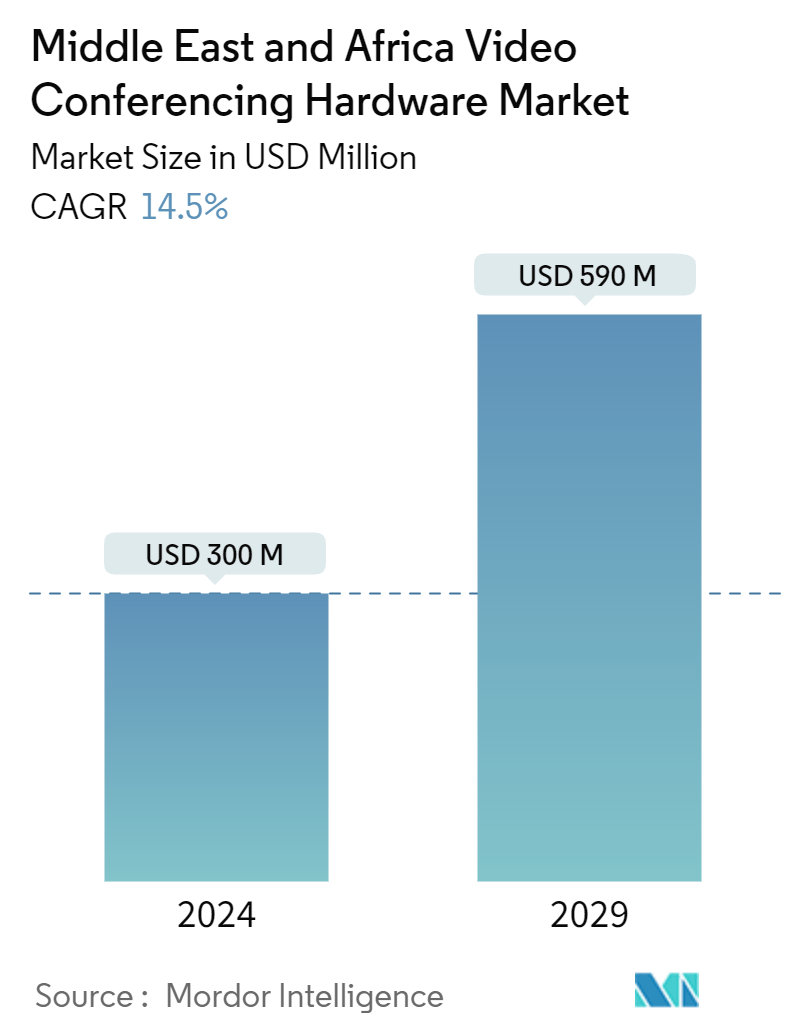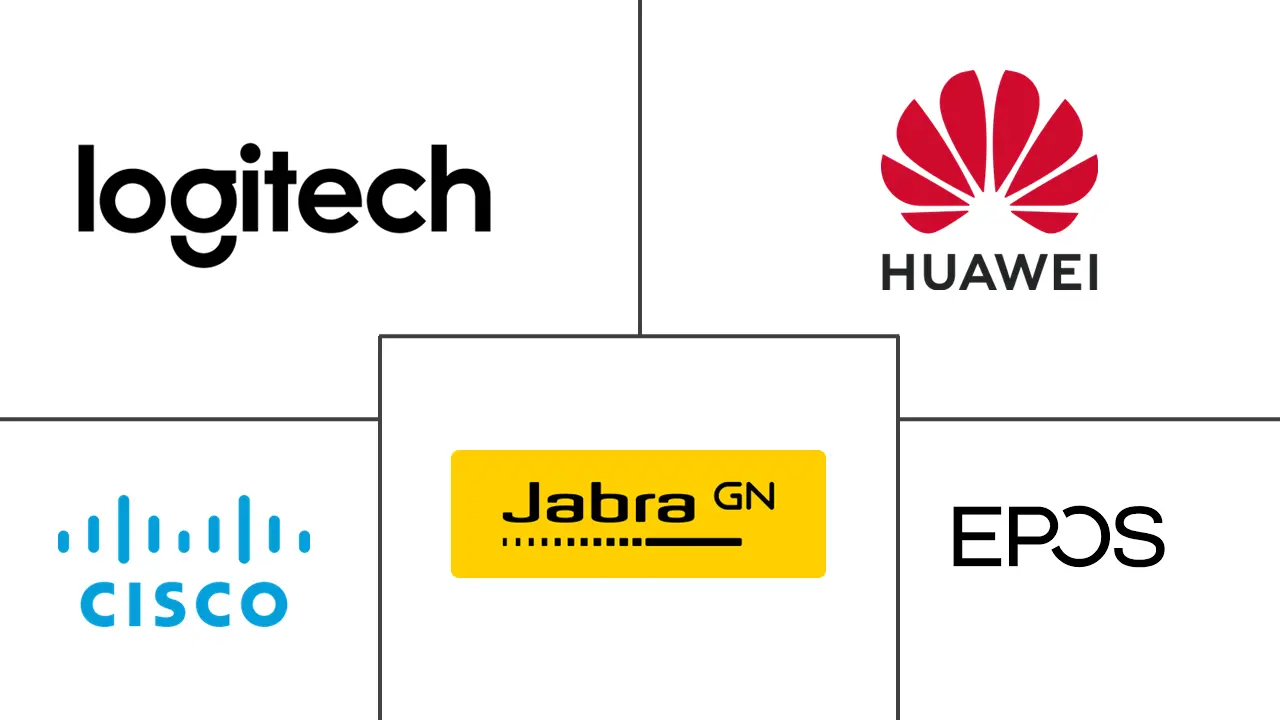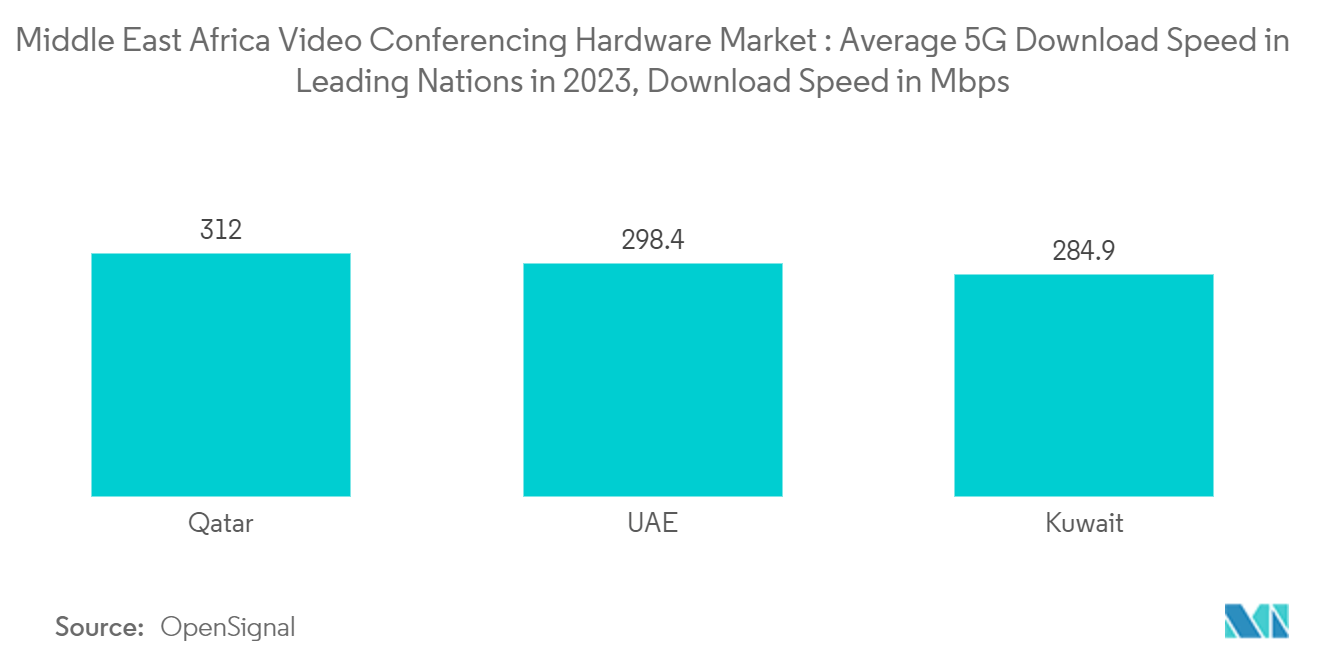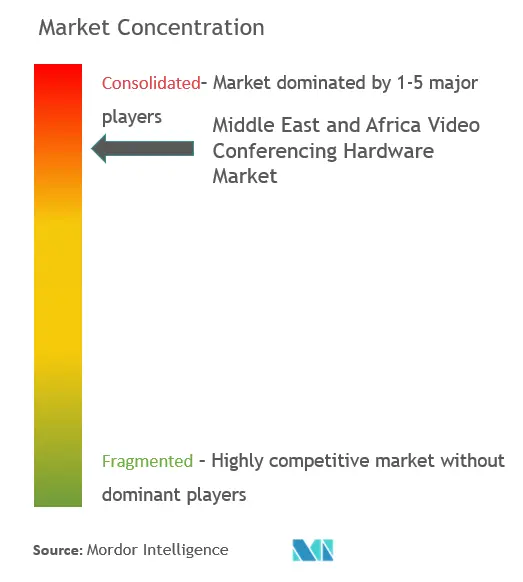Middle East & Africa Video Conferencing Hardware Market Size

| Study Period | 2022 - 2029 |
| Base Year For Estimation | 2023 |
| Market Size (2024) | USD 300 Million |
| Market Size (2029) | USD 590 Million |
| CAGR (2024 - 2029) | 14.50 % |
| Market Concentration | High |
Major Players
*Disclaimer: Major Players sorted in no particular order |
Middle East & Africa Video Conferencing Hardware Market Analysis
The Middle East & Africa Video Conferencing Hardware Market size is estimated at USD 300 million in 2024, and is expected to reach USD 590 million by 2029, growing at a CAGR of 14.5% during the forecast period (2024-2029).
The Middle East and Africa video conferencing hardware market growth is driven by institutions' continuous investment in the latest technology and enterprises' growing hybrid work culture. The market is changing drastically due to changes in the work culture and workplaces in the Middle East and Africa. Technological advancements in hardware such as cameras, MCUs, codec systems, enterprise headsets, and USB-based integrated bars drive the video conferencing hardware market.
Further, enterprise headsets gained traction in recent years owing to increased work-from-home and remote communication in the digital world. The continuous technological advancement in audio technology, including beamforming, noise cancellation, and high-fidelity audio capture, increases the demand for high-quality microphones across institutions and commercial spaces.
The demand for high-resolution cameras gained traction owing to the rising demand for remote collaboration solutions and the growth of the remote work culture drive. Continuous innovation and upgradation in the existing hardware create huge market opportunities. The advancement of MCUs accelerated group meetings, enabling the effortless integration of inputs from various sources. Further, modern MCUs integrate advanced features like transcoding that boost their potential to handle many participants with variable codec requirements bandwidth. Such features drive the hardware growth.
The adoption of video conferencing hardware in the Middle East and African institutions such as schools, colleges, and universities has significantly increased, especially during and after the pandemic, accelerating the shift to online learning. Also, the demand for better-quality cameras, headsets, and MCUs has accelerated and is expected to increase in the coming years.
An ongoing military and political conflict, as well as the Israeli–Palestinian conflict, has disrupted the whole Middle East and African economies. Owing to war, the countries are mainly focusing on the military and defense sectors, which is expected to reduce the market's growth. Such war and geopolitical tensions are anticipated to lower economic growth and increase inflation, leading to slow market growth.
Middle East & Africa Video Conferencing Hardware Market Trends
Commercial Spaces are Expected to Hold Significant Market Share
The commercial spaces are expected to hold a significant share in the Middle East and Africa video conferencing hardware market owing to the ongoing development in the commercial sector of countries such as UAE, Bahrain, Saudi Arabia, and other GCC countries, as well as South Africa. Video conferencing, or virtual meetings, is a widely used communication method across the sector. It helps businesses to save money on travel and increase productivity. Commercial spaces use it to communicate with customers, vendors, and employees from anywhere in the world.
One main advantage of video conferencing for team communication is that it reduces team travel. This means that teams can spend less time on the road and more time on work. Additionally, better communication and decision-making lead to increased productivity and accountability. With video conferencing, businesses can communicate with people from all over the world in real time.
Unlike email and phone calls, which are asynchronous, businesses can see people's faces, body language, and environment with video conferencing, which helps them understand customer context. This has made video conferencing an essential tool for business professionals to build a robust network of professionals. It can be used for various purposes, such as job interviews, building relationships with partners, connecting with clients, and simply catching up with friends and family.
Further, the ongoing development to expand the 5G network across the region creates new market opportunities for growth. In addition, integrating the latest video conferencing application into the hardware expands the equipment's capabilities and attracts new customers. For example, in June 2023, Poly introduced the innovative Poly Studio X52 Dubai. This cutting-edge camera operates the Google Meet application directly in appliance mode, simplifying meeting room setup.

The United Arab Emirates is Expected to Hold Significant Market Share
The UAE has a thriving start-up and business culture, with over 40% of its start-ups being tech-based. The UAE’s remote work system has become an important safety valve, safeguarding the security of society members and allowing them to carry out their day-to-day activities with ease and comfort.
The UAE government is stepping up its efforts to speed up the adoption of digital solutions. Through its initiatives and projects, it aims to create and define the digital future, which will help the UAE become a global leader in various fields. In February 2024, the United Arab Emirates funded USD 200 million for developing advanced technology in developing nations. The Abu Dhabi government finances the capital, which will be overseen by the Gulf state's Advanced Technology Research Council (ATRC).
Further, the country is continuously focusing on AI and cloud development. High-tech international companies actively invest in the country, creating new market opportunities in the coming years. For instance, in April 2024, Microsoft Corporation invested USD 1.5 billion in G42, the UAE-based artificial intelligence (AI) technology company, to bring the latest Microsoft AI technologies and skilling initiatives to the UAE.
Further, the country's ongoing development of new commercial spaces supports market growth. In addition, the increased network bandwidth with the 5G network supports the country's growth. For example, the UAE led the Middle East and the world in internet exchange traffic and 5G network speeds, as per the UAE Digital Economy Council in 2023. The UAE was the world’s fastest 5G market in the second quarter of 2023, as reported by Ookla’s Speedtest Intelligence.

Middle East & Africa Video Conferencing Hardware Industry Overview
The Middle East and Africa video conferencing hardware market is consolidated and dominated by leading vendors such as Jabra, Poly, Cisco Systems Inc., Logitech International SA, Huawei Technologies Co. Ltd, and EPOS. Companies continuously focus on enhancing their market presence by launching new products, expanding their operations, or entering strategic mergers and acquisitions, partnerships, and collaborations.
In March 2024, Cisco launched new, multifunctional devices that provide modernized collaboration experiences to a hybrid workforce. The new Cisco Board Pro G2 device is a touch-enabled and AI-powered collaboration device. Cisco Desk Phone 9800 Series is designed to bring a personalized and modern productivity hub to any desk. Cisco Board Pro G2 offers optimized camera views that help to improve hybrid teamwork.
In March 2024, Logitech International launched Mevo Core, a next-generation live-streaming camera. The new 4K camera is designed for content creation and live streaming and can be controlled from a tablet or smartphone.
Middle East & Africa Video Conferencing Hardware Market Leaders
-
EPOS
-
Jabra
-
Cisco Systems Inc.
-
Logitech International S.A.
-
Huawei Technologies Co., Ltd
*Disclaimer: Major Players sorted in no particular order

Middle East & Africa Video Conferencing Hardware Market News
- In May 2024, Logitech launched the MeetUp 2, an AI-enhanced USB conference camera tailored for both bring-your-own-device (BYOD) and PC-based setups, specifically in small meeting rooms and huddle spaces. This successor to the renowned Logitech MeetUp, which boasts a sales record of over one million units, introduces advanced AI video and audio capabilities, incorporates recycled plastics, and offers straightforward deployment for USB-connected huddle rooms.
- January 2024: Crestron Electronics Inc. launched a new AI-based PTZ camera series, the 1 Beyond, designed to address the challenges of modern hybrid meetings. The series includes four new cameras, each integrated with advanced optical zoom technology to preserve pixel quality and image integrity.
Middle East & Africa Video Conferencing Hardware Market Report - Table of Contents
1. INTRODUCTION
- 1.1 Study Assumptions and Market Definition
- 1.2 Scope of the Study
2. RESEARCH METHODOLOGY
3. EXECUTIVE SUMMARY
4. MARKET INSIGHTS
- 4.1 Market Overview
-
4.2 Industry Attractiveness - Porter's Five Forces Analysis
- 4.2.1 Threat of New Entrants
- 4.2.2 Bargaining Power of Buyers/Consumers
- 4.2.3 Bargaining Power of Suppliers
- 4.2.4 Threat of Substitute Products
- 4.2.5 Intensity of Competitive Rivalry
- 4.3 Impact of COVID-19 Aftereffects and Other Macroeconomic Factors on the Market
5. MARKET DYNAMICS
-
5.1 Market Drivers
- 5.1.1 Technological Development in Camera and MCUs
- 5.1.2 The Adoption of Hybrid or Remote Work Methods by Regional Organizations
-
5.2 Market Challenges
- 5.2.1 Data Security Concerns
6. MARKET SEGMENTATION
-
6.1 By Type of Hardware
- 6.1.1 Multi Control Units (MCU)
- 6.1.2 Collaboration Bars
- 6.1.3 Codec Systems
- 6.1.4 USB Cameras
- 6.1.5 USB-based Integrated Bars
- 6.1.6 Other Bundled Kits
- 6.1.7 Enterprise Headsets
-
6.2 By End User
- 6.2.1 Institutions
- 6.2.2 Commercial Spaces
-
6.3 By Country***
- 6.3.1 Saudi Arabia
- 6.3.2 United Arab Emirates
- 6.3.3 GCC
- 6.3.4 South Africa
7. COMPETITIVE LANDSCAPE
-
7.1 Company Profiles*
- 7.1.1 Cisco Systems Inc.
- 7.1.2 Logitech International SA
- 7.1.3 EPOS
- 7.1.4 Jabra
- 7.1.5 Poly Inc.
- 7.1.6 Huawei Technologies Co. Ltd
- 7.1.7 Crestron Electronics Inc.
8. Market Outlook
** Subject To AvailablityMiddle East & Africa Video Conferencing Hardware Industry Segmentation
The study tracks the revenue accrued through the sale of video conferencing hardware by various players in the Middle East and Africa. The study also tracks the key market parameters, underlying growth influencers, and major vendors operating in the industry, which will support the market estimations and growth rates during the forecast period. The study further analyses the overall impact of COVID-19 aftereffects and other macroeconomic factors on the market. The report’s scope encompasses market sizing and forecasts for the various market segments.
The Middle East and Africa video conferencing hardware market is segmented by product (multi control units (MCU), collaboration bars, codec systems, USB cameras, USB-based integrated bars, other bundled kits, and enterprise headsets), end users (institutions and commercial spaces), and country (Saudi Arabia, the United Arab Emirates, GCC except for UAE and Saudi Arabia, South Africa, and Rest of Middle East & Africa). The market sizes and forecasts regarding value (USD) for all the above segments are provided.
| By Type of Hardware | Multi Control Units (MCU) |
| Collaboration Bars | |
| Codec Systems | |
| USB Cameras | |
| USB-based Integrated Bars | |
| Other Bundled Kits | |
| Enterprise Headsets | |
| By End User | Institutions |
| Commercial Spaces | |
| By Country*** | Saudi Arabia |
| United Arab Emirates | |
| GCC | |
| South Africa |
Middle East & Africa Video Conferencing Hardware Market Research FAQs
How big is the Middle East & Africa Video Conferencing Hardware Market?
The Middle East & Africa Video Conferencing Hardware Market size is expected to reach USD 300 million in 2024 and grow at a CAGR of 14.5% to reach USD 590 million by 2029.
What is the current Middle East & Africa Video Conferencing Hardware Market size?
In 2024, the Middle East & Africa Video Conferencing Hardware Market size is expected to reach USD 300 million.
Who are the key players in Middle East & Africa Video Conferencing Hardware Market?
EPOS, Jabra, Cisco Systems Inc., Logitech International S.A. and Huawei Technologies Co., Ltd are the major companies operating in the Middle East & Africa Video Conferencing Hardware Market.
What years does this Middle East & Africa Video Conferencing Hardware Market cover, and what was the market size in 2023?
In 2023, the Middle East & Africa Video Conferencing Hardware Market size was estimated at USD 256.5 million. The report covers the Middle East & Africa Video Conferencing Hardware Market historical market size for years: 2022 and 2023. The report also forecasts the Middle East & Africa Video Conferencing Hardware Market size for years: 2024, 2025, 2026, 2027, 2028 and 2029.
Middle East & Africa Video Conferencing Hardware Industry Report
Statistics for the 2024 Middle East & Africa Video Conferencing Hardware market share, size and revenue growth rate, created by Mordor Intelligence™ Industry Reports. Middle East & Africa Video Conferencing Hardware analysis includes a market forecast outlook for 2024 to 2029 and historical overview. Get a sample of this industry analysis as a free report PDF download.



